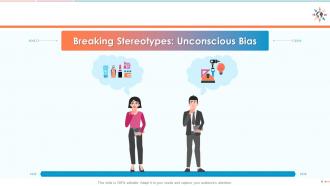Diversity and inclusion training on breaking stereotypes unconscious bias edu ppt
This module explains the concept of Stereotypes in detail. It explains the psychosocial reasons behind formation of Stereotypes. It goes onto explain examples of stereotyping e.g. Racial, Gender, Cultural and Sexual profiling. It also highlights adverse effects of stereotyping at workplace and ways to combat it.
You must be logged in to download this presentation.
 Impress your
Impress your audience
Editable
of Time
PowerPoint presentation slides
Presenting Diversity and Inclusion Training on Breaking Stereotypes Unconscious Bias. This deck contains designed slides. Our PowerPoint experts have included all the necessary templates, designs, icons, graphs and other essential material. This deck is well crafted by an extensive research. Slides consists of amazing visuals and appropriate content. These PPT slides can be instantly downloaded with just a click. Compatible with all screen types and monitors. Supports Google Slides. Premium Customer Support available. Suitable for use by managers, employees and organizations. These slides are easily customizable. You can edit the colour, text, icon and font size to suit your requirements.
People who downloaded this PowerPoint presentation also viewed the following :
Content of this Powerpoint Presentation
Slide 2
The purpose of the following slide is to provide an overview of implicit bias. It also contains details regarding ways through which this bias is developed, such as direct personal experiences, experiences of one's family members, friends, colleagues, and through media.
Slide 3
The purpose of this slide is to highlight the common examples of stereotyping such as racial profiling, gender profiling, cultural profiling, groups of individuals, and sexual stereotypes.
Instructor’s Notes:
- Racial Profiling:
- People from a certain racial profile are good at sports
- People from a certain nationality are good at mathematics
- Gender Profiling:
- People from a certain gender are messy and unclean
- People from a certain gender are not good at sports
- Cultural Profiling:
- People a certain religion are terrorists
- People a certain religion are greedy
- Groups of Individuals:
- Top management never cares about employees
- All teenagers are rebels
- Sexual Stereotypes:
- A feminine man and a masculine woman have a certain sexual orientation
Slide 4
This slide highlights the negative effects of stereotypes at the workplace, such a conflict, low morale, low productivity, poor employee retention, and litigation.
Instructor’s Notes:
- Conflicts:
- Stereotyping employees/colleagues instead of evaluating them on capabilities result in conflicts. Thus, making the workplace toxic
- Low Morale and Productivity:
- When constantly subjected to negative comments or criticisms due to stereotyping, employees lose motivation to perform allocated tasks
- Poor Employee Retention:
- Since stereotyping results in a non-supportive and non-inclusive environment, it leads to a high attrition rate in employees
- Non Diversified Workforce
- Stereotyping results in a non-diversified workforce as it results in hiring, promoting, and retaining individuals with similar viewpoints, impacting overall creativity at the workplace
- Litigation:
- A frustrated and stereotyped employee can file a discrimination case in court which can adversely impact the organization’s brand image.
Slide 5
The purpose of the following slide is to highlight the strategies to overcome stereotype threats at the workplace, such as look outing for undermining signals, re-allocating tasks, sharing diversity-rich content, and implementing policies that promote equal opportunities for all.
Instructor’s Notes:
- Lookout for Undermining Signals
- Managers should regularly conduct meetings with their team members and empathically ask if they are subjected to stereotyping
- Reallocating Tasks
- Ensure that each team working on a project has members from diverse genders, educational backgrounds, and cultures
- Sharing Diversity Rich Content
- Regularly share content with organization employees that focus on the importance of diversity via newsletters, infographics, and short videos.
- Implementing Policies
- Implement policies that help in breaking stereotyping, such as
- Providing equal career growth opportunities irrespective of gender and race
- Scrutinizing and updating the metrics used for hiring and promotion decisions
- Implement policies that help in breaking stereotyping, such as
Additional Slide 1
This slide contains icons related to Diversity and Inclusion in the same color theme that can be used by you to provide additional information of your own.
Additional Slide 2
This slide can be edited by anyone to provide information about your organization. The slide is using the same color theme and similar design elements as the main deck.
Additional Slide 3
This slide contains editable 30-60-90-day plan and is completely editable to suit presenter’s needs.
Additional Slide 4
This slide contains a roadmap template which you can edit to communicate your roadmap in an impactful way.
Additional Slide 5
This fully editable slide contains Activity Calendar for Diversity & Inclusion activities that you can plan for your teams.
Additional Slide 6
This fully editable slide contains timelines for your plan around implementing Diversity & Inclusion agenda in your organization.
Diversity and inclusion training on breaking stereotypes unconscious bias edu ppt with all 12 slides:
Use our Diversity And Inclusion Training on Breaking Stereotypes Unconscious Bias Edu Ppt to effectively help you save your valuable time. They are readymade to fit into any presentation structure.
-
Content of slide is easy to understand and edit.
-
I discovered this website through a google search, the services matched my needs perfectly and the pricing was very reasonable. I was thrilled with the product and the customer service. I will definitely use their slides again for my presentations and recommend them to other colleagues.
































